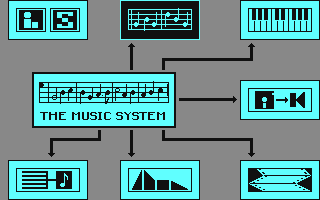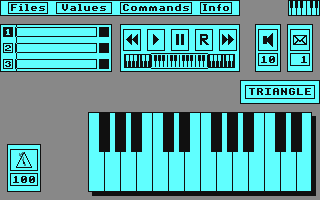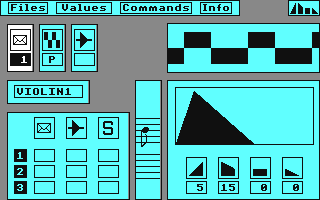|
A music software reviewer's lot is not always a happy
one. Many times he is asked to pit his wits on your
behalf against programs that defy all credibility, some
of which should never have seen the light of day. However,
the Advanced Music System, is the exception. In short
it is THE system, and no self-respecting 64 owner with
half a percent of musical interest should be without
one.
TAKING
ADVANTAGE OF SID
The
program was originally designed for the BBC and in 1983
consisted of a music editing and synthesiser program.
The Island record company at this time were looking
for a music system and joined forces with the original
designers. Prototypes of the system found their way
onto some of the company's record releases. After nine
months of intensive teamwork, the Music System was launched.
Development for the 64 meant many improvements to the
software in order to take full advantage of the capabilities
of the SID chip. Further receding and reworking of the
system has now culminated in this, the most complete
system for an eight-bit micro. 'But what does it do?',
I hear you ask. 'Everything' is more or less the straight
answer.
The
AMS (Advanced Music System) will create, edit, play
and print music. It allows music to be entered and played
back either using the 64's internal chip or through
an external MIDI keyboard or synthesiser. Sounds created
on the SID chip can be stored for future use. The result
can be printed in proper musical notation along with
any lyrics you may have. Apparently, it will play continuously
for about fifty hours if you tell it to!

MUSICAL
ICONOGRAPHY
On
loading up, the control screen displays icons, graphic
representations of the various modules that make up
the system. These are: Editor, Keyboard, Synthesiser,
Linker, Printer and MIDI. By depressing the space bar
the module you want can be highlighted and hence accessed.
There are keys common to each module that increase or
decrease values. Once into a selected module, a set
of icons appear that represent relevant functions. Across
the top of the display is a command line giving you
the option of Files, Values, Commands and Information.
Accessed via the function keys these appear, like other
sections within the module, as pop-up windows, thus
enabling many more parameters to be altered and files
lo be stored easily. The graphics are of an exceptional
quality not usually found on music software, and clearly
much care and thought lies behind their creation. The
colours are carefully chosen to be clear, without burning
the back of your eyes out.

The
Keyboards mode is probably the most immediately satisfying.
Highlight the keyboard icon, press return, and the AMS
retrieves the relevant part from the disk. The top two
rows of keys become a piano keyboard and correspond
to the piano keyboard represented on screen. Among other
icons and facilities there are plenty of preset voices,
a visual and audible metronome, as well as a facility
for real-time recording on three channels. The record/playback
icon is cleverly laid out like the controls of a cassette
recorder, even down to having a two-button operation
for recording, All music played or recorded can be scrolled
in proper notation on a pop-up window. This is definitely
the place for the non-performer to start. By selecting
Files from the command line, the user can choose from
ten demonstration tunes that show off the power of the
program.

[This
was the only screenshot in the original review]
THE
EDITOR
Tunes
created in the Keyboard module can be transferred to
the Editor module. This is a powerful music processor
akin to a word processor. Each note may be altered,
accented, rather cleverly made to sound louder, or deleted
altogether if need be. You can also edit all three voices
-- albeit one at a time. As with all editors, it can
be used to tidy up the whole piece, correcting timing
errors and setting overall volumes and sound; checking
your musical grammar, so to speak. There is a 'cut and
paste' facility, called 'notepad' that enables you to
move whole sections around within the composition. The
key and key signature can also be varied. A constant
barmeter display makes sure you know where you are.
Repeats and loops of certain sections can be created
both here and in the keyboard mode, which is great for
creating rhythmic backing tracks a la breakdance
or Jean-Michel Jarre. Having set up short tunes, these
can later be merged and stored on disks on Files. I
realise that if you are a musical non-starter this could
present problems at first, but the logical presentation
of the AMS is a great help in getting you to come to
terms with the pen and ink side of music.

SYNTH
AND MERGE
The
Synthesiser module gives you complete control over the
sound chip, with clear graphic representation of the
fifteen basic parameters for each sound you create.
Tunes can be fetched from Files and run through with
your newly created sound. Parameters can be swopped
from voice to voice and all new voices named and stored
for later use.
The
Linker is, in effect, a giant file-merging utility.
It allows large compositions consisting of up to twenty
six separate smaller music files to be linked together
and played back as one piece of music in any predestined
order. Having created your music, it only remains for
the two other modules to assist you in setting the musical
world on fire. By using the MIDI link, you can have
up to six separate keyboards/synthesisers controlled
from your 64 via a MIDI interface. The manual claims
that most 64 MIDI interfaces work with the AMS. It is
also possible to enter music from the external keyboards.
For the final professional touch, the Printer module
provides you with very high quality music notation,
as well as giving you the option to print lyrics over
the top of your music -- and correctly spaced too! Hard
copy can be obtained from Commodore and Epson type printers
(but don't try it with a daisy wheel, idiot!)
IN
CONCLUSION
This
is a very fine program indeed and is acceptable to even
the least musical amongst us. It is protected by a Lenslok
device, about which the least said the better . . .
. The disks themselves can, however, be copied. I would
have welcomed an easy start approach in the handbook,
but you can't have everything I suppose. At less than
£40 it blows away any competition that comes within
a good two hundred pounds of its price tag.
The
only limitation is the SID chip. Further development
of the MIDI module could very easily make this an extremely
powerful controlling and compositional tool. If you
want to explore music on your Commodore, then don't
waste your money on sub-standard or exotically-priced
software. Get this one.
|